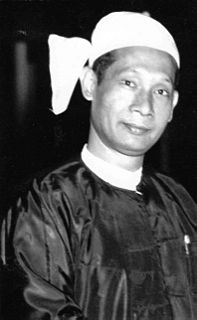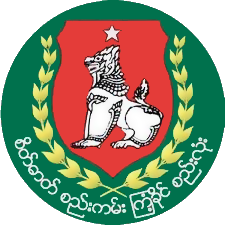
Bogyoke Aung San served as the 5th Premier of the British Crown Colony of Burma from 1946 to 1947. Initially he was a communist and later a social democratic politician. He was known as a revolutionary, nationalist, and as the founder of the Tatmadaw, and is considered the Father of the Nation of modern-day Myanmar. He was one of the founders of the Communist Party of Burma.

The Anti-Fascist People's Freedom League, or hpa hsa pa la (ဖဆပလ) by its Burmese acronym, was the main political alliance in Burma from 1945 until 1958. It was founded by the Communist Party of Burma (CPB) led by Thakin Soe, the Burma National Army (BNA) led by Aung San, and the People's Revolutionary Party (PRP) at a meeting held between 1–3 March 1945 as a reorganised version of the Anti-Fascist Organisation (AFO), formed to resist the Japanese occupation. The new organisation aimed to resist the Japanese occupation and achieve independence.

Ba Swe was the second Premier of Burma. He was a leading Burmese politician during the decade after the country gained its independence from Britain in 1948. He held the position of prime minister from 12 June 1956 to 28 February 1957. When Ba Swe became prime minister, Time magazine reported the news in an article titled: 'The Day of the Tiger' based on his nickname 'Big Tiger' since his university days in the 1930s as a student leader.

General elections were held for the first time in Singapore on 20 March 1948, when six of the 22 seats on the Legislative Council became directly-elected. Voting was not compulsory and was restricted to British subjects, who constituted around 2% of the 940,000 population. Although various organisations called for a boycott of the elections, voter turnout was 63.1%.

General elections were held in Singapore on 10 April 1951 to elect nine seats on the Legislative Council, up from six seats in the 1948 elections. A 32-day-long campaign period was scheduled, with nomination day on 8 March 1951. The result was a victory for the Progressive Party, which won six of the nine seats.

Bo Hmu Aung, born San Hlaing was a member of the Thirty Comrades. He has served as Speaker of the Chamber of Deputies, was the lower house of the bicameral Union Parliament of Burma.

Dobama Asiayone, commonly known as the Thakhins, was a Burmese nationalist group formed around the 1930s and composed of young, disgruntled intellectuals. Drawing their name from the way in which the British were addressed during colonial times, the party was established by Ba Thaung in May 1930, bringing together traditionalist Buddhist nationalist elements and fresh political ideals. It was significant in stirring up political consciousness in Burma, and drew most of its support base from students.

The fourth legislative council election to Madras Presidency after the establishment of dyarchical system of government by the Government of India Act, 1919 in September 1930. Justice party won the election and P. Munuswamy Naidu became the first Chief Minister. The main opposition party - Swaraj Party did not contest the elections due to its participation in the Civil Disobedience Movement.

The second legislative council election to Madras Presidency after the establishment of dyarchical system of government by the Government of India Act, 1919 was held in 1923. Voter turnout was higher than the previous election. Swarajists, a breakaway group from Indian National Congress participated in the election. The ruling Justice Party had suffered a split, when a splinter group calling themselves anti-Ministerialists left the party. It won the highest number of seats but fell short of a majority. Nevertheless, Madras Governor Willington invited it to form the government. Incumbent Justice chief minister Panagal Raja was nominated by party leader Theagaraya Chetty to continue as chief minister for a second term. The government survived a no-confidence motion, brought against it on the very first day of its tenure by the opposition headed by C. R. Reddy.

The Union Solidarity and Development Party, which was registered on 8 June 2010 by the Union Election Commission, currently standing as an opposition political party, is the successor to the Burmese government's mass organisation, the Union Solidarity and Development Association. It was headed by President Thein Sein until 2013, and its headquarters are in Naypyidaw's Dekkhinathiri Township.

The Assembly of the Union is the national-level bicameral legislature of Myanmar established by the 2008 National Constitution. The Pyidaungsu Hluttaw is made up of two houses, the Amyotha Hluttaw, a 224-seat upper house as well as the Pyithu Hluttaw, a 440-seat lower house.

General elections were held in Burma on 26 November 1936. The Government of Burma Act 1935 separated Burma from British India as of 1 April 1937, and created a 36-seat Senate and a 132-seat House of Representatives. The pro-constitution United GCBA of U Ba Pe emerged as the largest bloc in the House of Representatives, winning 46 seats. However, few parties were willing to work with U Ba Pe, and the Governor invited Ba Maw to form a government, despite his Poor Man's Party winning only 16 seats. Maw became Chief Minister after forming a coalition with Chit Hlaing and other "moderate extremists".

Elections to the Legislative Council were held in Burma on 17 November 1925. Under the terms of the dyarchy constitution, the Legislative Council of Burma was advisory to the British colonial governor, and had some direct authority over education, local government, public health, agriculture and forests. The Nationalist Party received the most votes, but was unable to form a government as the British authorities favoured the Independent Party, who formed a government led by Joseph Maung Gyi.

The Young Men's Buddhist Association (YMBA) was a Buddhist cultural organisation in Burma.

Aung Zan Wai was a Burmese politician. He was born in Sittwe, Kyauktaw, British Burma in 1893. Aung Zan Wai, along with Pe Khin, Bo Hmu Aung, Sir Maung Gyi, Sein Mya Maung, Myoma U Than Kywe were most important negotiators and leaders of the historical Panglong Conference negotiated with Burma national top leader Aung San and other top leaders in 1947. All these leaders decided to join together to form the Union of Burma. The signing is now celebrated as a national holiday, Union Day, in Myanmar.

Sir Joseph Augustus Maung Gyi was a Burmese barrister, judge, diplomat, politician and administrator who served as the Acting Governor of British Burma during the tenure of Charles Alexander Innes, who was away on sick leave in the United Kingdom. He had served variously cabinet minister such as Minister of Forestry, Minister of Home Affairs, Minister of Education and Public Health during the colonial era.

















